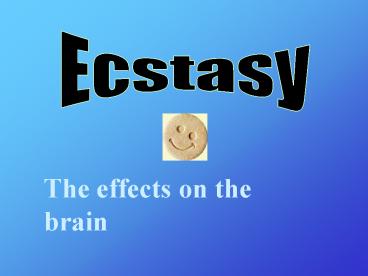Ecstasy PowerPoint PPT Presentation
Title: Ecstasy
1
Ecstasy
The effects on the brain
2
Ecstasy Is...
a synthetic, psychoactive drug with
hallucinogenic like properties. The active
compound in ecstasy is Methylenedioxymethamphetam
ine (MDMA).
3
MDMA is usually taken orally in pill form, but
snorting has also been reported. Ecstasy can be
found at raves, dance clubs, and college scenes.
Popularity of Ecstasy 2000 (Monitoring the
Future Study)
8th Grade 10th Grade 12th
Grade Ever Used 4.3
7.3 11.0 Used in past
year 3.1 5.4
8.2 Used in past month 1.4
2.6 3.6
4
Surprisingly, MDMA can be found being sold in
bars in Denver. It is used by many different
ages but has been become the drug of choice among
white middle class young adults in Washington
D.C. In Boston during the first three quarters of
2000, MDMA was the most frequently mentioned drug
in telephone calls to the Poison Control Center.
5
Physical Symptoms
- Muscle tension
- Involuntary teeth clenching
- Nausea
- Blurred Vision
- Rapid eye movement
- Faintness
- Chills
- Sweating
- Increase in heart rate
- Increase in blood pressure
6
Phycological Difficulties
- Severe anxiety
- Paranoia
- Drug craving
- Confusion
- Depression
- Sleep problems
These complications may persist weeks after
taking MDMA. A rash that looks like acne can also
develop after the use of ecstasy. Side effects
also include liver damage if there is a continual
use.
7
MDMA affects the neurons that use the chemical
serotonin to communicate to other neurons. The
serotinin systems are in charge of regulating
aggression, sleep, sexual activity, and
sensitivity to pain. Long term effects from
prolonged usage of MDMA affects the part of the
brain critical to the thought of memory. In a
study done on primates showed that exposure to
MDMA for 4 consecutive days caused brain damage
that was evident to six to seven years later.
In The Brain
PowerShow.com is a leading presentation sharing website. It has millions of presentations already uploaded and available with 1,000s more being uploaded by its users every day. Whatever your area of interest, here you’ll be able to find and view presentations you’ll love and possibly download. And, best of all, it is completely free and easy to use.
You might even have a presentation you’d like to share with others. If so, just upload it to PowerShow.com. We’ll convert it to an HTML5 slideshow that includes all the media types you’ve already added: audio, video, music, pictures, animations and transition effects. Then you can share it with your target audience as well as PowerShow.com’s millions of monthly visitors. And, again, it’s all free.
About the Developers
PowerShow.com is brought to you by CrystalGraphics, the award-winning developer and market-leading publisher of rich-media enhancement products for presentations. Our product offerings include millions of PowerPoint templates, diagrams, animated 3D characters and more.

